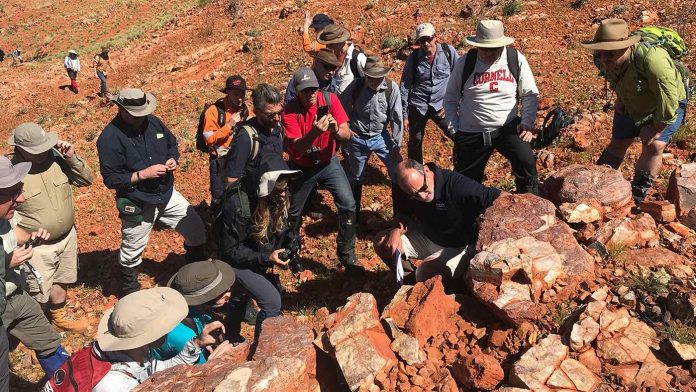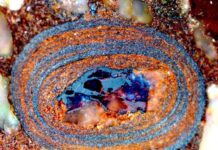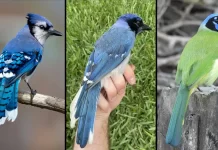As any geologist worth his or her salt will tell you, there are rocks, and then there are rocks. Next July, NASA and the European Space Agency (ESA) are launching rovers to Mars that will search for signs of past microbial life, and to find them, the scientists with NASA’s Mars 2020 mission and ESA’s ExoMars will need to examine different kinds of rocks that lend compelling insights into the environment in which they were made – all from 100 million miles away.
“While we expect to find many significant rocksduring both Mars 2020 and ExoMars missions, we also have to leave open the possibility we could find one or more very specialrocks,the kind whose discovery would not only speak volumes about the history of Mars but contribute significantly to the discussion of life elsewhere in the universe,” said Ken Farley, Mars 2020 project scientist at Caltech in Pasadena.
Guided by Martin Van Kranendonk, director of the Australian Centre for Astrobiology at the University of New South Wales, members of the two missions’ science teams went on an expedition to northwestern Australia’s Pilbara region to analyze, discuss and debate stromatolites – structures preserved in rock that formed in water on early Earth and contain a fossilized record of ancient microbial life. Among the science teams’ stops: a stromatolite cluster in a grouping of rock called the Dresser Formation that contains some of the oldest known fossilized records of life on our world.
“Some 3.48 billion years ago, this area was home to a caldera, or collapsed volcano, filled with hot, bubbling seawater,” said Van Kranendonk. “At the same time, this location was also home to structures called microbial mats – visible to the naked eye but composed of microscopic organisms. Today you would know them as simple pond scum, but back thenthey were the most complex lifeforms on Earth.”
Likely powered by photosynthesis, along with the heat and chemical energy in the caldera, these mats lived at the water’s edge, secreting a mucous that would trap grains of sediment swirling around in the water. Over time, sheet after sheet of these microbes trapped sediment on top of previous layers. When the seawater receded and the pond scum dried up and disappeared millennia later, what remained was striking evidence of this co-evolution of geology and biology.
“A stromatolite is quite subtle to the untrained eye,” said Van Kranendonk. “But once you know the details, you recognize that these wavy, wrinkly rocks have a structure different from that which can be explained by just geology.”
Past Life on Mars?
Of course, the Outback isn’t Mars, but what happened in the Dresser Formation a billion years ago and what happened on the Red Planet at roughly the same time share some eerie similarities.
Between 3 billion and 4 billion years ago at the Mars 2020 landing site, Jezero Crater, a river flowed into a body of water the size of Lake Tahoe, depositing delta sediments packed with clay and carbonate minerals. The conditions were ideal for stromatolites to form on the shorelines, which is one key reason the rover team will be touching down there in February 2021. “It’s hard to think of a better recipe for life to thrive – and for its record to be preserved – than the one we see at Jezero,” said Ken Williford, deputy project scientist for Mars 2020 at JPL.
If stromatolites ever existed in Jezero or at Oxia Planum, the ExoMars landing site, the teams need to know what to look for, hence this trip to the Outback. But that’s not the only reason they came.
“I organized this first joint Mars 2020-ExoMars science expedition so scientists from our two great missions could gain a new perspective on these one-of-a-kind stromatolites; a laboratory setting just can’t provide the same context,” said Mitch Schulte, Mars 2020 program scientist at NASA Headquarters in Washington. “That applies to the experience as a whole, too – the conversations, comparing of notes and planning for future exchanges that was done here in the Pilbara will go a long way to advance Mars science.”
Two Missions, Two Rovers
While the two missions both seek to find evidence of past life, each is approaching the challenge in its own way. Touching down about a week after Mars 2020, the ExoMars rover, otherwise known as the Rosalind Franklin, carries a core drillthat on two or more occasions will bore almost 7 feet (2 meters) into the Martian crust. The rover will analyze the samples onsite with a sophisticated suite of scientific instruments.
The coring mechanism on NASA’s Mars 2020 rover drills shallower holes but is designed to collect more than 40 rock and soil core samples. There will be on-site analysis of rocks at the coring sites, and the samples themselves will be sealed in metal tubes that will ultimately be deposited by the rover at specific sites. Future missions could then retrieve those samples and return them to Earth for the sort of laboratory analysis that just isn’t possible on Mars.
“These two Mars missions will be revolutionary because they are complementary,” said Teresa Fornaro, a science team member for the Mars Organic Molecule Analyzer instrument aboard ExoMars. “Two different rovers with two different sets of instruments, exploring at the same time two different landing sites. Some of the capabilities of Mars 2020 in characterizing the surface environment could help guide ExoMars on where to drill. Conversely, knowledge of the alteration of possible organics as a function of depth by ExoMars could help Mars 2020 select the most interesting surface samples to collect for future return to Earth.”
When the joint Mars 2020-ExoMars science Outback expedition concluded in late August, the science teams went their separate ways. But to those who honed their stromatolite-hunting skills in the Pilbara, the influence of the trip continues.
“What is happening working out here in the field is also happening in the halls of NASA and ESA,” said Schulte. “Finding evidence of life on another world, if it ever existed, will require tenacity and a whole lot of brainpower. If there is a stromatolite in the range of the rovers, I think we have a good chance of finding it … and we’ll find it together. This trip will have helped with that.”
The launch window for Mars 2020 opens on July 17, 2020. It will land at Mars’ Jezero Crater on Feb. 18, 2021. The launch window for ExoMars opens July 25, 2020. It will land at Oxia Planum in March 2021.
JPL is building and will manage operations of the Mars 2020 rover for the NASA Science Mission Directorate at the agency’s headquarters in Washington. NASA will use Mars 2020 and other missions, including to the Moon, to prepare for human exploration of the Red Planet. The agency intends to establish a sustained human presence on and around the Moon by 2028 through NASA’s Artemis lunar exploration plans. The ExoMars program is a joint endeavor between the European Space Agency and the Russian Federal Space Agency (Roscosmos).















